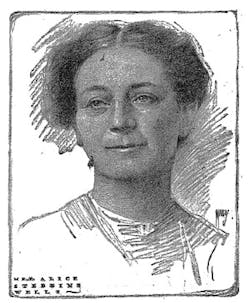I've taken some heat for neglecting women in this column. I must admit, I am remiss. I even let an article go to the dogs before I included a woman officer. So, off I went to research women in law enforcement. Unfortunately, there isn't a great deal written on the subject. So, I figured I would go back to the source... who was the first female officer? I'm not even referring to the Police Matrons that were assigned to jails and children's homes. I'm talking about having arrest powers. Well, here is where it gets tricky.
In the late 19th Century, many municipalities employed women to assist in the handing of women and children in jails, prisons and mental health institutions. By the 1840s, most police departments in the United States had in their employ police Matrons. These women were not what we consider a police officer today (they did not carry a weapon and did not have arrest powers), but they were instrumental in leading the way for today's women with a badge.
This brings us to the question: Who was the first female law enforcement officer? On April 1, 1908 (really, no joke), the city of Portland, Oregon appointed Lola Baldwin (48) as a sworn female detective to perform police service. Baldwin was previously employed by the Portland Travelers' Aid Society in an effort to keep women and children from the "moral pitfalls" surrounding the Lewis and Clark Exposition (what would be considered a fair today). Apparently, the great many single men that came to the area for the exposition made the city fathers nervous. City leaders were so impressed by Lola's performance that the mayor, city council and chief of police decided to create her position within the police department. Lola served as the Superintendent of the Women's Auxiliary to the Police Department for the Protection of Girls. This, of course, followed her passing of the specialized female detective civil service exam (the exam was created specifically for Officer Baldwin). While Officer Baldwin would eventually serve a 14 year career as the firsts police woman with powers of arrest, she viewed her role more as crime prevention than enforcement.
In September 1910, two years after Lola Baldwin's appointment, Alice Stebbins Wells was selected by the Los Angeles Police Department and assigned to their Juvenile Bureau. Mrs. Wells, a 37 year old assistant pastor and licensed social worker with two college degrees, was appointed after the city council unanimously decreed an ordinance providing for one police officer who shall be a woman. Her selection attracted national exposure because she was a social worker, educated and actively sought the position. Her job required her to handle all female and juvenile cases and to investigate social conditions that led women and children to become involved in crime. She was assigned to work with Officer Leo W. Marden, the department's first juvenile officer.
Subsequent to Officer Wells' appointment, the LAPD issued the following:
No young girl can be questioned by a male officer. Such work is delegated solely to policewomen, who, by their womanly sympathy and intuition, are able to gain the confidence of their younger sisters.
This doesn't exactly sound like the LAPD was specifically looking out for the well being of the young girls, but it does pave the way for an increase in the number of policewomen nationally. In fact, by 1912 the LAPD had three policewomen and three matrons on the payroll. By 1916, sixteen other cities and several foreign countries had hired policewomen. Officer Wells was instrumental in the formation of the International Policewomen's Association (founded 1915).
So great was the impact of Alice Stebbins Wells that the University of California, Southern Division (now UCLA) offered course work specifically for women police officers within the Criminology Department (summer session 1918). Officer Wells was named the first president of the Women's Peace Officers Association of California and in July of 1934 was appointed to the position of LAPD historian. She would hold this title until retiring in November 1940 after serving the City of Los Angeles for 30 years. Mrs. Wells died in August 1957. Her honor guard consisted of ten policewomen in full dress uniform.
These are two remarkable women that, literally, opened the doors for others to follow. The years following these would involve policewomen in almost every aspect of police work (including aerial officers). I promise that I will dedicate more of this space to the women that have followed in their footsteps.
About the Author
Charles Bennett
Charles Bennett was born in our Nation's Capital and grew up in the Maryland suburbs. Mr. Bennett has been working in all aspects of the publishing industry since the late 1980s primarily in the fields of commercial photography and magazine production. Moving to California in 1992 to attend college resulted in B.F.A and Masters degrees. California also supplied Mr. Bennett with his wife. The two of them are avid sports persons and participate in shooting, scuba diving, surfing, running and bicycling. As a long time hobby Mr. Bennett has studied the legends of American law enforcement which led to his writing these columns.

